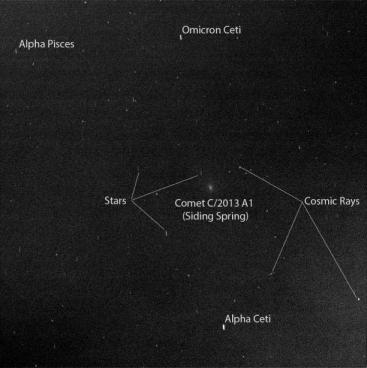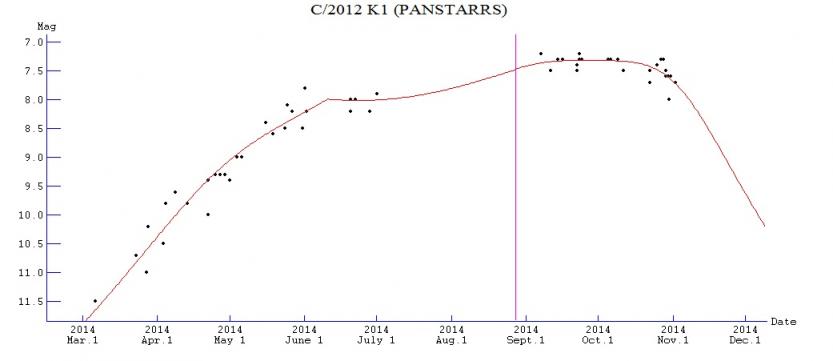COMET SECTION NEWS FOR NOVEMBER 2014
2014-November-5
Latest News
The comet event of October was the incredible close flyby of Mars by long-period comet C/2013 A1 (Siding Spring). Though the comet was a visual letdown (it experienced a rapid fade from 10th to 12th magnitude in the weeks prior to the flyby), CCD imagers made a number of beautiful images contrasting the faint blue-green comet with brilliant red Mars. At least 7 spacecraft near or on Mars observed the comet. Though we are still awaiting the most of the results, images from the HiRise imager on the Mars Reconnaissance Orbiter found the comet’s nucleus to be smaller than expected at ~0.5 km across.

The first comet imaged from the surface of another world. C/2013 A1 (Siding Spring) from the Mars Exploration Rover (MER) Opportunity. Credit: NASA/JPL-Caltech/Cornell Univ./ASU/TAMU
November brings another comet spacecraft related first as the European Rosetta spacecraft deploys the Philae lander onto the surface of short-period comet 67P/Churyumov-Gerasimenko (scheduled for Tuesday, November 12).
Comet Section members (Salvador Aguirre, Carl Hergenrother, Gary T. Nowak, Willian Souza) have contributed visual and CCD magnitude estimates during October for comets C/2012 K1 (PANSTARRS), C/2012 X1 (LINEAR), C/2013 A1 (Siding Spring), C/2013 US10 (PANSTARRS), C/2014 E2 (Jacques), C/2014 Q1 (PANSTARRS), C/2014 Q2 (Lovejoy), C/2014 Q3 (Borisov) and C/2014 R1 (Borisov). CCD images for comets 17P/Holmes, 32P/Comas Sola, 108P/Ciffreo, 110P/Hartley 3, 201P/LONEOS, C/2011 J2 (LINEAR), C/2013 A1 (Siding Spring), C/2013 V4 (Catalina), C/2014 E2 (Jacques), C/2014 Q3 (Borisov) and C/2014 R1 (Borisov) were submitted by Denis Buczynski, Manos Kardasis and Gianluca Masi. Some of the more interesting observations were made of the outbursting Halley-family comet C/2014 Q3 (Borisov) and split comet C/2011 J2 (LINEAR).
Evening Comets
C/2012 K1 (PANSTARRS) [Perihelion on 2014-Aug-27 at 1.05 AU from the Sun]
As November begins, C/2012 K1 (PANSTARRS) is the only comet bright enough to be easily seen in small telescopes or binoculars. But this is only true for southern hemisphere or low northern latitude observers. For the majority of us at northern mid-latitudes, the comet will be too far south this month. The comet comes back north in late December but it may be too faint for most backyard observers by then. CCD observers should be able to follow it for many months into the future. This month K1 moves through the constellations of Pictor (Oct 1-5), Dorado (6-10), Reticulum (10-19), Eridanus (19-23) and Phoenix (23-31).
Since the comet reappeared in early September after solar conjunction, 29 visual magnitude estimates have been submitted to the Section from Willian Souza (24!), Salvador Aguirre (2), Carl Hergenrother (2) and Gary T. Nowak (1). The comet has held steady around magnitude 7.5, give or take a few tenths of a magnitude, over the past few months. This month should see the comet starts to fade into obscurity as it moves away from the Sun (1.49 to 1.83 AU) and Earth (0.95 to 1.46 AU).

Lightcurve of comet C/2012 K1 (PANSTARRS) from visual magnitude estimates submitted to the ALPO Comet Section by Salvador Aguirre, Carl Hergenrother, Gary T. Nowak, John Sabia and Willian Souza.
Recent ALPO images and observations of C/2012 K1 (PANSTARRS) can be found in the Comet Section Image Gallery and Magnitude Database. Finder charts can be found on the Comet Chasing website.
Morning Comets
C/2014 Q2 (Lovejoy) [Perihelion on 2015-Jan-30 at 1.29 AU from the Sun]
A year ago, comet C/2013 R1 (Lovejoy) was a nice bright winter comet. This year Terry Lovejoy of Australia may have done it again. His latest comet, C/2014 Q2 (Lovejoy) is rapidly brightening and should be a small telescope/binocular object by the end of November. Since its discovery on August 17 it has increased in brightness from 14th to 10th magnitude. This is a rapid rate of brightening. Whether it continues is still to be seen but it suggests that the new Lovejoy may be a nice 7th to 8th magnitude comet in January/February as it passes within 1.29 AU of the Sun (on January 30) and 0.47 AU of Earth (January 7/8).
Similar to PANSTARRS this month, Comet Lovejoy is a far southern object this month and northern observers will have to wait till late December for a clear view. As the comet approaches the Sun (1.84 to 1.57 AU) and Earth (1.67 to 1.05 AU), it moves slowly near the border of Vela and Puppis. Two visual observations by Salvador Aguirre and 2 CCD observations by Carl Hergenrother have been received by the Section for C/2014 Q2.
Recent ALPO images and observations of C/2014 Q2 (Lovejoy) can be found in the Comet Section Image Gallery and Magnitude Database. Finder charts can be found on the Comet Chasing website.
New Discoveries
Only two comets were discovered since the last Comet Section News update. Both comets were found by Richard Kowalski of the Catalina Sky Survey. P/2014 U2 (Kowalski) was first spotted on October 18 at 18th magnitude. At discovery, the comet was just past perihelion (1.17 AU) and perigee (0.38 AU). The fact that it was still only 18th magnitude when so close to the Sun and Earth makes this Comet Kowalski a very faint comet intrinsically. It returns to perihelion in 2019. The other new Comet Kowalski is C/2014 U3, a long-period comet discovered on October 26 at 19th magnitude. With perihelion on October 10, 2014 at 2.58 AU from the Sun, this comet will not get any brighter.
As always, the Comet Section is happy to receive all comet observations, whether images, drawings or magnitude estimates.
- Carl Hergenrother (ALPO Comet Section Coordinator)



